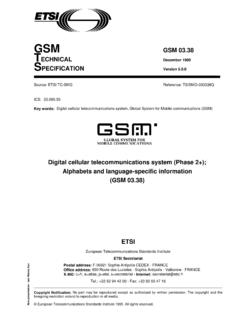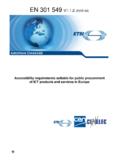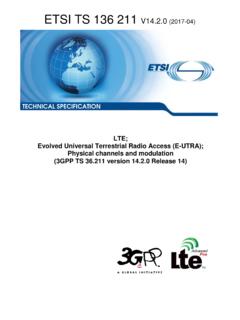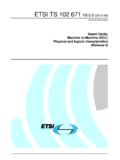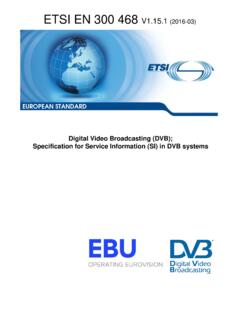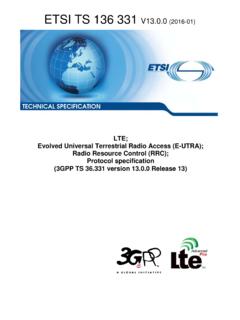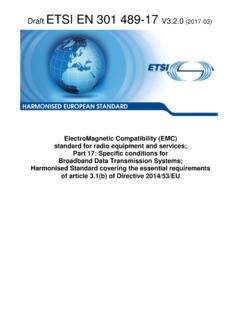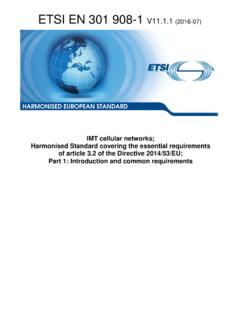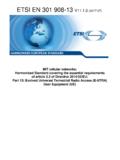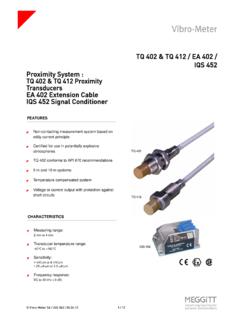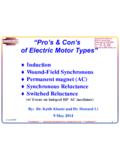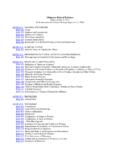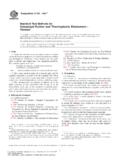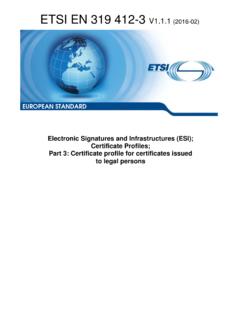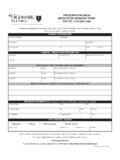Transcription of EN 319 412-1 - V1.1.1 - Electronic Signatures and ...
1 ETSI EN 319 412-1 (2016-02) Electronic Signatures and Infrastructures (ESI); Certificate Profiles; Part 1: Overview and common data structures EUROPEAN STANDARD ETSI ETSI EN 319 412-1 (2016-02) 2 Reference DEN/ESI-0019412-1 Keywords e-commerce, Electronic signature, security, trust services ETSI 650 Route des Lucioles F-06921 Sophia Antipolis Cedex - FRANCE Tel.: +33 4 92 94 42 00 Fax: +33 4 93 65 47 16 Siret N 348 623 562 00017 - NAF 742 C Association but non lucratif enregistr e la Sous-Pr fecture de Grasse (06) N 7803/88 Important notice The present document can be downloaded from: The present document may be made available in Electronic versions and/or in print.
2 The content of any Electronic and/or print versions of the present document shall not be modified without the prior written authorization of ETSI. In case of any existing or perceived difference in contents between such versions and/or in print, the only prevailing document is the print of the Portable Document Format (PDF) version kept on a specific network drive within ETSI Secretariat. Users of the present document should be aware that the document may be subject to revision or change of status. Information on the current status of this and other ETSI documents is available at If you find errors in the present document, please send your comment to one of the following services: Copyright Notification No part may be reproduced or utilized in any form or by any means, Electronic or mechanical, including photocopying and microfilm except as authorized by written permission of ETSI.
3 The content of the PDF version shall not be modified without the written authorization of ETSI. The copyright and the foregoing restriction extend to reproduction in all media. European Telecommunications Standards Institute 2016. All rights reserved. DECTTM, PLUGTESTSTM, UMTSTM and the ETSI logo are Trade Marks of ETSI registered for the benefit of its Members. 3 GPPTM and LTE are Trade Marks of ETSI registered for the benefit of its Members and of the 3 GPP Organizational Partners. GSM and the GSM logo are Trade Marks registered and owned by the GSM Association. ETSI ETSI EN 319 412-1 (2016-02) 3 Contents Intellectual Property Rights.
4 4 Foreword .. 4 Modal verbs terminology .. 4 Introduction .. 5 1 Scope .. 6 2 References .. 6 Normative references .. 6 Informative references .. 6 3 Definitions and abbreviations .. 7 Definitions .. 7 Abbreviations .. 7 4 ETSI EN 319 412 certificate profiles .. 7 General approach .. 7 Overview of other parts of ETSI EN 319 412 .. 8 ETSI EN 319 412-2 .. 8 ETSI EN 319 412-3 .. 8 ETSI EN 319 412-4.
5 8 ETSI EN 319 412-5 .. 8 5 Common data structures .. 9 Semantics identifiers .. 9 General .. 9 module .. 9 Natural person semantics identifier .. 10 Legal person semantics identifier .. 10 History .. 12 ETSI ETSI EN 319 412-1 (2016-02) 4 Intellectual Property Rights IPRs essential or potentially essential to the present document may have been declared to ETSI. The information pertaining to these essential IPRs, if any, is publicly available for ETSI members and non-members, and can be found in ETSI SR 000 314: "Intellectual Property Rights (IPRs); Essential, or potentially Essential, IPRs notified to ETSI in respect of ETSI standards", which is available from the ETSI Secretariat.
6 Latest updates are available on the ETSI Web server ( ). Pursuant to the ETSI IPR Policy, no investigation, including IPR searches, has been carried out by ETSI. No guarantee can be given as to the existence of other IPRs not referenced in ETSI SR 000 314 (or the updates on the ETSI Web server) which are, or may be, or may become, essential to the present document. Foreword This European Standard (EN) has been produced by ETSI Technical Committee Electronic Signatures and Infrastructures (ESI). The present document is part 1 of a multi-part deliverable covering the Certificate Profiles, as identified below: Part 1: "Overview and common data structures"; Part 2: "Certificate profile for certificates issued to natural persons"; Part 3: "Certificate profile for certificates issued to legal persons"; Part 4: "Certificate profile for web site certificates"; Part 5: "QCStatements".
7 National transposition dates Date of adoption of this EN: 22 February 2016 Date of latest announcement of this EN (doa): 31 May 2016 Date of latest publication of new National Standard or endorsement of this EN (dop/e): 30 November 2016 Date of withdrawal of any conflicting National Standard (dow): 30 June 2017 Modal verbs terminology In the present document "shall", "shall not", "should", "should not", "may", "need not", "will", "will not", "can" and "cannot" are to be interpreted as described in clause of the ETSI Drafting Rules (Verbal forms for the expression of provisions). "must" and "must not" are NOT allowed in ETSI deliverables except when used in direct citation.
8 ETSI ETSI EN 319 412-1 (2016-02) 5 Introduction ITU and ISO issued standards for certification of public keys in Recommendation ITU | ISO/IEC 9594-8 [ ] which are used for the security of communications and data for a wide range of Electronic applications. Regulation (EU) No 910/2014 [ ] of the European Parliament and of the Council of 23 July 2014 on Electronic identification and trust services for Electronic transactions in the internal market and repealing Directive 1999/93/EC defines requirements on specific types of certificates named "qualified certificates". Implementation of Directive 1999/93/EC [ ], superseded by the Regulation (EU) No 910/2014 [ ], and deployment of certificate infrastructures throughout Europe as well as in countries outside of Europe, have resulted in a variety of certificate implementations for use in public and closed environments, where some are declared as qualified certificates while others are not.
9 Applications need support from standardized and interoperable identity certificates profiles, in particular when applications are used for Electronic Signatures , authentication and secure Electronic exchange in open environments and international trust scenarios, but also when certificates are used in local application contexts. This multi-part deliverable aims to maximize the interoperability of systems issuing and using certificates both in the European context under the Regulation (EU) No 910/2014 [ ] and in the wider international environment. ETSI ETSI EN 319 412-1 (2016-02) 6 1 Scope The present document provides an overview of the Recommendation ITU-T | ISO/IEC 9594-8 [ ] based certificate profiles and the statements for EU Qualified Certificates specified in other parts of ETSI EN 319 412 [ ] to [ ].
10 It specifies common data structures that are referenced from other parts of ETSI EN 319 412 [ ] to [ ]. The profiles specified in this multi-part deliverable aim to support both the Regulation (EU) No 910/2014 [ ] and use of certificates in a wider international context. Within the European context, it aims to support both EU Qualified Certificates and other forms of certificate. 2 References Normative references References are either specific (identified by date of publication and/or edition number or version number) or non-specific. For specific references, only the cited version applies. For non-specific references, the latest version of the referenced document (including any amendments) applies.
